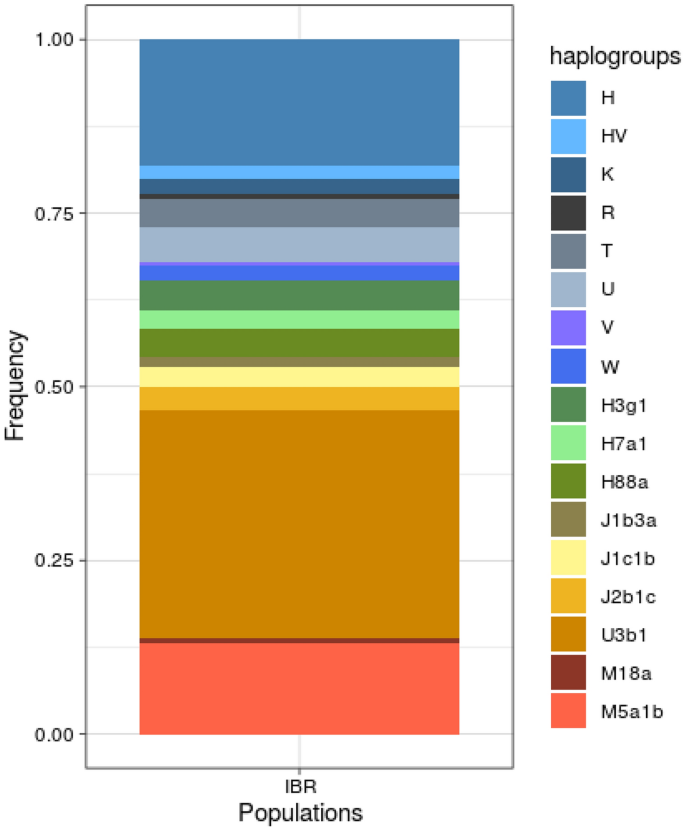kingjohn
Regular Member
- Messages
- 2,218
- Reaction score
- 1,181
- Points
- 113
Abstract
The Roma are the largest ethnic minority in Europe. With a Northwestern Indian origin around ~ 1.5 kya, they travelled throughout West Asia until their arrival in Europe around the eleventh century CE. Their diaspora through Europe is characterized by population bottlenecks and founder events which have contributed to their present day genetic and cultural diversity. In our study, we focus on the effects of founder effects in the mitochondrial DNA (mtDNA) pool of Iberian Roma by producing and analyzing 144 novel whole mtDNA sequences of Iberian Roma. Over 60% of their mtDNA pool is composed by founder lineages of South Asian origin or acquired by gene flow during their diaspora in the Middle East or locally in Europe in Europe. The TMRCA of these lineages predates the historical record of the Roma arrival in Spain. The abundance of founder lineages is in contrast with ~ 0.7% of autochthonous founder lineages present in the non-Roma Iberian population. Within those founder lineages, we found a substantial amount of South Asian M5a1b1a1 haplotypes and high frequencies of West Eurasian founder lineages (U3b1c, J2b1c, J1c1b, J1b3a, H88, among others), which we characterized phylogenetically and put in phylogeographical context. Besides, we found no evidence of genetic substructure of Roma within the Iberian Peninsula. These results show the magnitude of founder effects in the Iberian Roma and further explain the Roma history and genetic diversity from a matrilineal point of view.
from the paper:
Our samples show 20 (13.9%) M South Asian haplotypes, mainly represented by M5a1b haplogroup sequences, and 124 (86.1%) West Eurasian haplotypes. Besides, our samples show 51% of West Eurasian founder lineages that had previously been described either by analysis of mitochondrial control regions (U3, H7, J1b3 or J1c1) or whole mitogenome analysis (H88a, U3b1c)23,24. In addition to these previously observed Roma founder lineages, we were also able to detect the presence of some new founder lineages within haplogroups H3g1 and J2b1c (Fig. 1). Overall, two founder lineages of South Asian origin were carried by 13.9% of the individuals of our Iberian Roma sample, while seven West Eurasian founder lineages reached a joint 51.4% population frequency.

Haplogroup composition in Iberian Roma. Founder lineages are detailed to the sub-haplogroup level
source:
https://www.nature.com/articles/s41598-022-23349-9
The Roma are the largest ethnic minority in Europe. With a Northwestern Indian origin around ~ 1.5 kya, they travelled throughout West Asia until their arrival in Europe around the eleventh century CE. Their diaspora through Europe is characterized by population bottlenecks and founder events which have contributed to their present day genetic and cultural diversity. In our study, we focus on the effects of founder effects in the mitochondrial DNA (mtDNA) pool of Iberian Roma by producing and analyzing 144 novel whole mtDNA sequences of Iberian Roma. Over 60% of their mtDNA pool is composed by founder lineages of South Asian origin or acquired by gene flow during their diaspora in the Middle East or locally in Europe in Europe. The TMRCA of these lineages predates the historical record of the Roma arrival in Spain. The abundance of founder lineages is in contrast with ~ 0.7% of autochthonous founder lineages present in the non-Roma Iberian population. Within those founder lineages, we found a substantial amount of South Asian M5a1b1a1 haplotypes and high frequencies of West Eurasian founder lineages (U3b1c, J2b1c, J1c1b, J1b3a, H88, among others), which we characterized phylogenetically and put in phylogeographical context. Besides, we found no evidence of genetic substructure of Roma within the Iberian Peninsula. These results show the magnitude of founder effects in the Iberian Roma and further explain the Roma history and genetic diversity from a matrilineal point of view.
from the paper:
Our samples show 20 (13.9%) M South Asian haplotypes, mainly represented by M5a1b haplogroup sequences, and 124 (86.1%) West Eurasian haplotypes. Besides, our samples show 51% of West Eurasian founder lineages that had previously been described either by analysis of mitochondrial control regions (U3, H7, J1b3 or J1c1) or whole mitogenome analysis (H88a, U3b1c)23,24. In addition to these previously observed Roma founder lineages, we were also able to detect the presence of some new founder lineages within haplogroups H3g1 and J2b1c (Fig. 1). Overall, two founder lineages of South Asian origin were carried by 13.9% of the individuals of our Iberian Roma sample, while seven West Eurasian founder lineages reached a joint 51.4% population frequency.

Haplogroup composition in Iberian Roma. Founder lineages are detailed to the sub-haplogroup level
source:
https://www.nature.com/articles/s41598-022-23349-9

